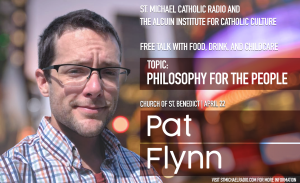Abortion is not just a religious issue
Today is #MarchforLife. It is the anniversary of the decision of Roe v. Wade. Hundreds of thousand Catholics and non-Catholics gather together today a march for life in DC and all across the nation. Tulsa is having a March for Life and I would like to invite you to join us! You can find more information here.
St. Michael Catholic Radio’s team is a huge fan of Trent Horn, a Catholic apologist/speaker/author, who has several show segments on the hit Catholic radio show Catholic Answers Live. You can visit their website here.
Trent has come out with a book called “Persuasive Pro-Life”. We highly recommend it! You can get the kindle version for FREE here.
Here is a little except from Trent’s book. Here’s 3 ways to be a better Pro-Lifer.
Here’s a couple other good blogs by Trent Horn regarding the pro-life issue:
I could keep going but for the sake of this blog, I will move forward. 🙂
We also want to give you 10 reasons why unborn babies are not part of a woman’s body:
1. Genetic Identity – The most basic observation. They both have a different genetic code.
2. Sex – The fetus (Latin word for “young one”) can be a different sex than the mother.
3. Blood Type – Contrary to popular thought, the unborn does not share a circulatory system or blood with the mother.
4. Transitive Possession of the Body Parts – If A is part of B and B is part of C, then necessarily, A must be part of C. This is called a transitive relation. The unborn is itself composed of parts. At eight weeks after conception, all the major organs we normally think of as body parts are present (even if not yet functioning). Now if the unborn has parts and the unborn is itself a part of the mother, then the parts of the unborn would have to be called parts of the mother. If A (unborn parts) is part of B (unborn) and B (unborn) is part of C (mother), then A (unborn parts) must be part of C (mother). But this leads to obvious absurdities. How many feet does a mother have at, say, 12 weeks gestation? Two or four? If we say that the unborn is a part of the mother then we would have to say four. We would also have to say that she has a penis, if she’s pregnant with a boy. But this is absurd. The only possibilities then are to deny the logical principle of the transitive relation or to deny that the unborn in a part of the mother. Logic suggests the latter.
5. Shifting Dependence – As evidence that the unborn is a part of the mother and not an individual, some will point to the fact that the unborn is dependent on the mother for nutrition and for survival. But “dependence” is a nebulous concept and is marked by degree. Every born person is dependent in some way on others, but they’re still individuals. There is no other case where one’s degree of dependence causes us to recognise them as a non-individual, so as a justification for abortion, dependence already seems to be a non sequitor.
6. Meaning of individual as self-contained whole – The unborn may be small (like many of us) and in varying ways dependent on the mother (like many of us), but this doesn’t take away from the fact that even the zygote, that single-celled new little individual, is in fact a wholeindividual.
7. Place does not equal part – It may seem obvious to say that the unborn is a part of the mother, since the child is actually inside the mother and is physically connected to her body. This does not make the unborn “part” of her though. Let’s consider the fact that the unborn is inside the mother first. Does x being inside y make x a part of y? It that’s the case, then you are a “part” of your car when you sit inside of it. Or consider a single brick in a wall. What makes this brick a part of thiswall? Is it merely place? Is it not rather, that the brick contributes to the wholeness of the wall and to its function? Furniture in a house is not part of the house (except in a metaphorical sense).
8. Wholeness of a non-pregnant Woman – How do parts come to be present in adult individuals? Organs develop, either prenatally or postnatally. At eight weeks gestational age, all major organs are formed, though they may not all function by this point. Consider what this would mean if the unborn were a “part” of a woman’s body. If the unborn were a part of a woman’s body, there would be two natural ways for the woman to develop this “part”. One possibility would be for her to be born pregnant, as women are born with other prenatally developed body parts, such as limbs, a brain, sex organs, lungs, a stomach, etc. Women are not born pregnant, and no one expects them to be. Women are born with certain organs or bodily parts which developed prenatally. The woman functions in a state of health without the presence of the unborn, so the unborn is not a “part” at any point prenatally.
9. Arguments from the Social Relationship between Mother and Unborn – One of the most exciting aspects of being an expectant parent is developing a social relationship with the unborn while still in utero. Parents talk to and about their unborn child. They (may) name their unborn child. They may even play with their child, for example poking or tapping a little elbow sticking out of the mother’s belly. No one names, plays with, or sings songs to their body parts, at least not seriously. There is also ample evidence to indicate that there is a tremendous amount of social learning that occurs before a child is even born. Interactions between twins are especially interesting (and cute). The parent-child relationship exists before the child is even born precisely because child is an individual and only individuals can be social with one another. This reality is exactly the reasonabortion providers want to avoid mothers seeing ultrasounds, naming their babies, or even referring to their unborn as “he” or “she”. So the unborn is an individual and not a part of the mother.
10. Meaning of part to whole – Mother as Part of the Unborn – The argument that the unborn is part of the mother suffers from a misunderstanding of what it means to be “part” of something. The essential element in the relationship of part to whole is not place, size, or even connectedness, but that the part exists and functions for the sake of the whole. Parts of things don’t explain themselves. They are not their own thing. They make sense only with reference to the whole they are a part of. For example, the wheel on a car does not explain itself. It is itself (if we can even speak that way) only when it is purposed toward the functioning of the whole car. In an individual being composed of parts, the nature of the parts is that they serve the whole. We can easily see then why the heart or lungs are parts of an individual by reference to what they contribute to the whole individual.
A VERY IMPORTANT NOTE:
All of what has been said here is simply to refute the biologically false slogan that the unborn is part of a woman’s body and that she therefore has the right to dispose of it (the hidden premise, that one is free morally to do whatever they wish with their own body, is also false, by the way). It in no way diminishes or reduces the dignity of the mother-child relationship to observe that both are unique individuals. The most amazing thing I have ever witnessed and been a part of has been seeing my wife become pregnant and give birth to our two boys. Not to mention everything else she does for us. Motherhood is freaking amazing.
Tulsa’s March for Life is January 22nd! Mass is at Holy Family Cathedral at 5:30p. The March starts at 7p. Join us and invite your friends! Take pictures and videos and use the hashtag #TulsaMarchforLife and we will repost some of the content!
St. Michael – Pray For Us
Read more on the 10 reasons here

